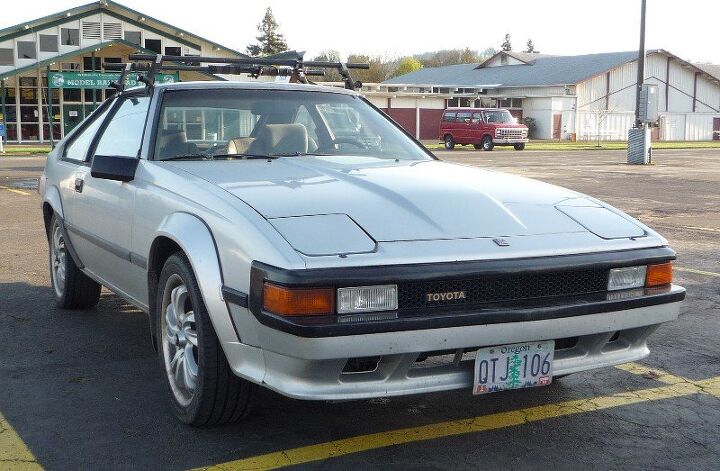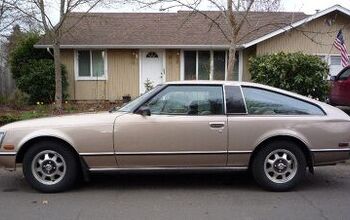Curbside Classic: 1984 Toyota Celica Supra Mk II

Wouldn’t it be fun to be able to go back in time and make different choices about the cars we bought? As I sit here and contemplate the qualities and my memories of the Mark II Supra, I ask myself just what the hell I was thinking when I bought that ’83 T-Bird Turbo Coupe instead of a Supra? Don’t remind me; it was in a moment of typical youthful impulsiveness. The Supra had it all over the noisy, thrashy, live-axle T-Bird: a silky-smooth DOHC inline six, more horsepower, IRS, four-wheel disc brakes, and Toyota’s superb build and material quality. Live and learn.
If t he first Supra was something of a Japanese Buick Riviera, favored for its smooth, soft manners, the Supra Mk II was closer to a BMW M3, at least in image if not actual performance. I say that from the perspective of living in LA during the Mark II’s heyday, when the same demographic that you might expect to see in an M3 in more recent times would very likely have been in a Supra Mk II: young, affluent, hip, and quite often Asian; in other words, almost the polar opposite of the Nissan 280 ZX demographic of the time. I may not have been hip or Asian, but I sure could see myself behind the wheel of one, unlike the Supra Mark I or the highly-unhip Zx.
The Mark II was still Celica based, with an extended front end for the longer engine. Somehow, this second nose job looks a bit less grafter on than the first one. Perhaps because the Japanese designers of this generation had the longer front end in mind from the get go. The smooth and rounder Mark I was based on the California Calty-designed Celica, a first for a Toyota. But this generation’s styling was brought back to the Japan-based studio, and it shows. The Japanese love for lots of angles and busy details is obvious, especially compared to the organic and simple shape of its predecessor. It may be the main reason why I grabbed for the T-Bird: it’s new slick aero-styling was much more my cup of (non-green) tea than this generation Celica and Supra.
But for a lover of inline sixes, the Supra’s engine was quite compelling: a classic in-line DOHC 2.8 liter unit, smooth and willing, for the times. From today’s vantage point, its power output looks modest at best, rising gently from 145 hp for the ’82 to 161 for the ’86. That’s just behind the Mustang GT’s numbers, 157 hp in ’82, and 175 from ’83 on. The Mustang was definitely the performance bargain of the time, but it wasn’t exactly a refined piece of machinery by any stretch.
The Mark II came in two distinct flavors: L for comfort, and P for performance. The P-type had fender flares, better tires and suspension tuning, eight-way seats, and an LSD. The L-type’s claim to fame was its optional fully-digital IP, with one of the first integrated trip computers. Very hot stuff in 1982. Very long-dead stuff in 2009. The P-type was the way to go for that reason alone, if not for the more obvious ones.
I had a brief drive in one of these, and the contrast to my Turbo Coupe was stark. In fact, they were pretty much polar opposites, given their similar genres. The TC felt lighter and a hair nimbler, for better or for worse. The Supra was almost Mercedes solid, and much less unflappable over broken pavement, with its four wheel independent suspension. The biggest difference was the engine, though. The TC’s little ex-Pinto four was horrendously thrashy the minute it hit 4,000 rpm; it was like a rev-limiter due to the pain it inflicted above that. But its power did come on in a fun if brief burst of turbo boost. The Supra’s engine had no real bite, just a steady smooth flow of power; refined and sophisticated in comparison. Not unlike the silky-smooth six in the W124 300E that replaced the Turbo Coupe in ’85. Now that’s one car buying decision I’ll never have regrets about.

More by Paul Niedermeyer
Latest Car Reviews
Read moreLatest Product Reviews
Read moreRecent Comments
- Redapple2 I gave up on Honda. My 09 Accord Vs my 03. The 09s- V 6 had a slight shudder when deactivating cylinders. And the 09 did not have the 03 's electro luminescent gages. And the 09 had the most uncomfortable seats. My brother bought his 3rd and last Honda CRV. Brutal seats after 25 minutes. NOW, We are forever Toyota, Lexus, Subaru people now despite HAVING ACCESS TO gm EMPLOYEE DISCOUNT. Despite having access to the gm employee discount. Man, that is a massive statement. Wow that s bad - Under no circumstances will I have that govna crap.
- Redapple2 Front tag obscured. Rear tag - clear and sharp. Huh?
- Redapple2 I can state what NOT to buy. HK. High theft. Insurance. Unrefined NVH. Rapidly degrading interiors. HK? No way !
- Luke42 Serious answer:Now that I DD an EV, buying an EV to replace my wife’s Honda Civic is in the queue. My wife likes her Honda, she likes Apple CarPlay, and she can’t stand Elon Musk - so Tesla starts the competition with two demerit-points and Honda starts the competition with one merit-point.The Honda Prologue looked like a great candidate until Honda announced that the partnership with GM was a one-off thing and that their future EVs would be designed in-house.Now I’m more inclined toward the Blazer EV, the vehicle on which the Prologue is based. The Blazer EV and the Ultium platform won’t be orphaned by GM any time soon. But then I have to convince my wife she would like it better than her Honda Civic, and that’s a heavy lift because she doesn’t have any reason to be dissatisfied with her current car (I take care of all of the ICE-hassles for her).Since my wife’s Honda Civic is holding up well, since she likes the car, and since I take care of most of the drawbacks of drawbacks of ICE ownership for her, there’s no urgency to replace this vehicle.Honestly, if a paid-off Honda Civic is my wife’s automotive hill to die on, that’s a pretty good place to be - even though I personally have to continue dealing the hassles and expenses of ICE ownership on her behalf.My plan is simply to wait-and-see what Honda does next. Maybe they’ll introduce the perfect EV for her one day, and I’ll just go buy it.
- 2ACL I have a soft spot for high-performance, shark-nosed Lancers (I considered the less-potent Ralliart during the period in which I eventually selected my first TL SH-AWD), but it's can be challenging to find a specimen that doesn't exhibit signs of abuse, and while most of the components are sufficiently universal in their function to service without manufacturer support, the SST isn't one of them. The shops that specialize in it are familiar with the failure as described by the seller and thus might be able to fix this one at a substantial savings to replacement. There's only a handful of them in the nation, however. A salvaged unit is another option, but the usual risks are magnified by similar logistical challenges to trying to save the original.I hope this is a case of the seller overvaluing the Evo market rather than still owing or having put the mods on credit. Because the best offer won't be anywhere near the current listing.






































Comments
Join the conversation
The last generation Supra stickered for over 40K in 1998 . Toyota literally priced them out of the range of the people who would buy them . The last one I saw on the showroom floor was priced at 44K . If the base model Mustangs were priced over 40k (let alone 12 years ago) they'd soon be gone also . By going after the BMW/Porsche crowd Toyota forgot who the real customer for the Supra was and how much car they could afford at that time .
I just bought one of these, and I'm stoked!